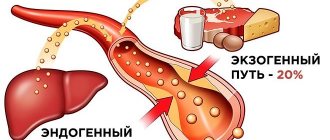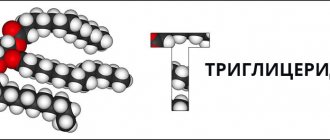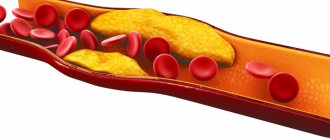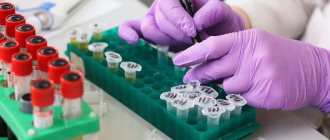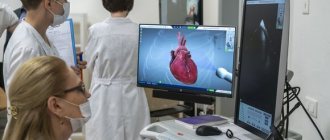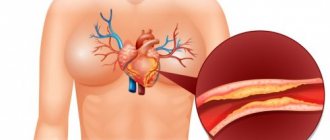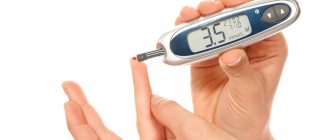Cholesterol – low density lipoproteins (LDL)
Low-density lipoproteins are the main carriers of cholesterol in the body. The cholesterol they contain is considered “harmful”, since its excess increases the risk of plaques appearing in the arteries, which can lead to blockage and cause a heart attack or stroke.
Synonyms Russian
LDL, low-density lipoprotein, LDL, LDL-C, low-density lipoprotein cholesterol, beta-lipoprotein cholesterol, beta-lipoprotein, beta-LP.
English synonyms
LDL, LDL-C, low-density lipoprotein cholesterol, Low-density lipoprotein.
Research method
Colorimetric photometric method.
Units
mmol/l (millimoles per liter).
What biomaterial can be used for research?
Venous blood.
How to properly prepare for research?
- Do not eat for 12 hours before donating blood.
- Avoid physical and emotional stress and do not smoke for 30 minutes before the test.
General information about the study
Cholesterol is a fat-like substance vital to the body. It is involved in the formation of cell membranes of all organs and tissues of the body. Hormones are created on the basis of cholesterol, which are necessary for the development of the body and the implementation of the reproduction function. Bile acids are formed from it, with the help of which fats are absorbed in the intestines.
Cholesterol is insoluble in water, so to move around the body it is “packed” into a protein shell consisting of apolipoproteins. The resulting complex (cholesterol apolipoprotein) is called a lipoprotein. Several types of lipoproteins circulate in the blood, differing in the proportions of their components:
- very low density lipoproteins (VLDL),
- low density lipoproteins (LDL),
- high density lipoproteins (HDL).
LDL cholesterol is considered “bad” because when it is in excess, plaques appear in the walls of blood vessels, which can restrict the movement of blood through the vessel, which threatens atherosclerosis and significantly increases the risk of heart disease (coronary disease, heart attack) and stroke.
The liver produces enough cholesterol for the body's needs, but some of it comes from food, mainly fatty meat and fatty dairy products. If a person has a genetic predisposition to high cholesterol or eats too much animal fat, LDL levels in the blood can rise to dangerous levels.
What is the research used for?
- To assess the likelihood of atherosclerosis and heart problems (this is the most important indicator of the risk of developing coronary disease).
- To monitor the effectiveness of a diet with a reduced amount of animal fats.
- To monitor lipid levels after the use of cholesterol-lowering drugs.
When is the study scheduled?
The LDL test is usually part of a lipid profile, which also includes the determination of total cholesterol, VLDL cholesterol, HDL cholesterol, triglycerides and atherogenicity coefficient. A lipidogram may be prescribed during routine preventive examinations or when the concentration of total cholesterol increases, in order to find out which fraction is responsible for the increase.
In general, a lipid profile is recommended for all people over 20 years of age at least once every 5 years, but in some cases even more often (several times a year). First, if the patient is prescribed a low-fat diet and/or is taking cholesterol-lowering medications, then they are tested to see if they are achieving target LDL and total cholesterol levels and thus reducing their cardiovascular risk. diseases. And, secondly, if the patient has one or more risk factors for developing cardiovascular diseases in his life:
- smoking,
- certain age (men over 45, women over 55),
- high blood pressure (from 140/90 mm Hg),
- high cholesterol or cardiovascular disease in family members (heart attack or stroke in a close male relative under 55 years of age or a female relative under 65 years of age),
- coronary heart disease, previous myocardial infarction or stroke,
- diabetes,
- excess body weight,
- alcohol abuse,
- eating large amounts of food containing animal fats,
- low physical activity.
If a child in the family had cases of high cholesterol or heart disease at a young age, then it is recommended that he take a lipid profile for the first time between the ages of 2 and 10 years.
What do the results mean?
Reference values: 0 - 3.3 mmol/l.
The concept of “normal” is not entirely applicable to the level of LDL cholesterol. Different people with different numbers of risk factors in their lives will have different normal levels of LDL cholesterol. LDL cholesterol testing is used to determine the risk of cardiovascular disease, but to accurately determine it for any person, all factors must be taken into account.
Increased LDL cholesterol levels may be the result of a hereditary predisposition (familial hypercholesterolemia) or excess dietary intake of animal fats. In most people with high cholesterol, both factors are involved to some extent.
LDL cholesterol levels can be assessed as follows:
- less than 2.6 mmol/l – optimal,
- 2.6-3.3 mmol/l – close to optimal,
- 3.4-4.1 mmol/l – borderline high,
- 4.1-4.9 mmol/l – high,
- above 4.9 mmol/l – very high.
Possible reasons for increased LDL cholesterol levels:
- cholestasis - stagnation of bile, which can be caused by liver disease (hepatitis, cirrhosis) or gallstones,
- chronic inflammation of the kidneys leading to nephrotic syndrome,
- chronic renal failure,
- decreased thyroid function (hypothyroidism),
- poorly treated diabetes mellitus,
- alcoholism,
- obesity,
- prostate or pancreatic cancer.
Reduced LDL cholesterol levels are not used in diagnosis due to low specificity. However, its reasons may be:
- hereditary hypocholesterolemia,
- severe liver disease,
- oncological diseases of the bone marrow,
- increased thyroid function (hyperthyroidism),
- inflammatory joint diseases,
- B12—or folate deficiency anemia,
- common burns,
- acute diseases, acute infections,
- chronic obstructive pulmonary disease.
What can influence the result?
Cholesterol concentrations may change from time to time, this is normal. A single measurement does not always reflect normal levels, so sometimes it may be necessary to retake the test after 1-3 months.
Increases VLDL cholesterol levels:
- pregnancy (lipid profile should be done at least 6 weeks after birth),
- long fasting,
- donate blood while standing,
- anabolic steroids, androgens, corticosteroids,
- smoking,
- eating food containing animal fats.
Reduce VLDL cholesterol levels:
- being in a lying position,
- allopurinol, clofibrate, colchicine, antifungal drugs, statins, cholestyramine, erythromycin, estrogens,
- intense physical activity,
- a diet low in cholesterol and saturated fatty acids and, conversely, high in polyunsaturated fatty acids.
Important Notes
- A lipid profile should be taken when a person is relatively healthy. After an acute illness, heart attack, or surgery, you should wait at least 6 weeks before measuring cholesterol.
- LDL is usually calculated using the following formula: LDL cholesterol = total cholesterol - (HDL cholesterol - TG (triglycerides) / 2.2).
- In the USA, lipids are measured in milligrams per deciliter, in Russia and Europe - in millimoles per liter. Conversion is carried out using the formula: cholesterol (mg/dl) = cholesterol (mmol/l) × 38.5 or cholesterol (mmol/l) = cholesterol (mg/dl) x 0.0259.
- LDL cholesterol is usually calculated based on the results of other tests included in the lipid profile: total cholesterol, HDL cholesterol and triglycerides, another type of lipid that is part of lipoproteins. More often, a fairly accurate indicator is achieved, but if the triglyceride level is significantly elevated (> 10 mmol/l) or the person ate a lot of fatty foods before taking the test, the result may not be entirely correct. In this case, LDL is measured directly.
Also recommended
- Triglycerides
- Cholesterol – high density lipoprotein (HDL)
- Atherogenic coefficient
- Apolipoprotein A1
- Apolipoprotein B
Who orders the study?
General practitioner, therapist, cardiologist.
Low-density lipoprotein cholesterol
– one of the very important indicators that a cardiologist relies on in his work. Yulia Mikhailovna Nikitina, cardiologist, functional diagnostics doctor at MEDSI Premium, talks in more detail about the importance of the study and the reasons for increased cholesterol levels.
Low-density lipoprotein cholesterol
– atherogenic fraction of cholesterol in the blood, which is a significant risk factor for the development of atherosclerosis and complications of cardiovascular diseases.
What is the research used for?
- to assess the likelihood of developing atherosclerosis and cardiovascular diseases;
- to monitor the effectiveness of a diet with a reduced amount of animal fats;
- to monitor lipid levels after taking cholesterol-lowering medications.
How to properly prepare for research?
- Do not eat for 8 hours before the test.
- Avoid physical and emotional stress and do not smoke for 30 minutes before the test.
Target indicators for each patient are calculated individually. In the absence of additional cardiac risk factors, the desired level is <3.0 mmol/l. Lower target values are recommended for patients at high cardiovascular risk. The level of low-density lipoproteins in some cases can be regulated by diet, but most often the use of lipid-lowering drug therapy in combination with diet is required.
Elevated LDL cholesterol levels may be the result of a hereditary predisposition (familial hypercholesterolemia) or excess dietary intake of animal fats. In most people with high cholesterol, both factors are involved to some extent.
Possible causes of increased low-density lipoprotein cholesterol levels:
- cholestasis - stagnation of bile, which can be caused by liver disease or gallstones;
- chronic inflammation of the kidneys, leading to nephrotic syndrome;
- chronic renal failure;
- decreased thyroid function (hypothyroidism);
- uncompensated diabetes mellitus;
- alcoholism;
- obesity;
- prostate or pancreatic cancer.
Reduced LDL cholesterol levels are not used in diagnosis due to low specificity. However, its reasons may be:
- hereditary hypocholesterolemia,
- severe liver disease,
- oncological diseases of the bone marrow,
- increased thyroid function (hyperthyroidism),
- inflammatory joint diseases,
- B12 or folate deficiency anemia,
- common burns,
- acute diseases, acute infections,
- chronic obstructive pulmonary disease.
To dynamically monitor the effectiveness of lipid-lowering therapy, both a routine lipid profile with calculation of LDL cholesterol using the Friedwald formula (using the results of measuring total cholesterol, HDL cholesterol and triglycerides) and methods of direct measurement of LDL cholesterol can be used.
Friedwald's formula/equation (developed in 1972) is as follows:
- LDL cholesterol = TC - HDL cholesterol - VLDL cholesterol
Where the amount of VLDL cholesterol (Very Low Density Lipoprotein Cholesterol) is calculated by dividing the triglyceride value by 5 or 2.2 (depending on the unit of measurement):
- VLDL cholesterol (mg/dl) = Triglycerides: 5
- VLDL cholesterol (mmol/l) = Triglycerides: 2.2
When calculating LDL cholesterol using the Friedwald formula, data on the average triglyceride/cholesterol ratio in residual lipoproteins is used. Because this ratio gradually increases in VLDL and chylomicrons as the severity of hypertriglyceridemia and chylomicronemia increases, at some levels the equation overestimates VLDL-C and therefore underestimates LDL-C. The Friedwald formula becomes increasingly inaccurate between triglyceride concentrations between 2.3 and 4.5 mmol/L and is considered invalid if triglyceride levels exceed 4.5 mmol/L.
An alternative to the Friedwald formula for assessing LDL cholesterol is the study of LDL cholesterol concentration by direct determination, which does not require additional tests for calculation.
Another, no less important problem of the calculation method for assessing LDL cholesterol is the low concentration of LDL cholesterol during lipid-lowering therapy. Both the inaccuracy and the bias of LDL cholesterol from the true value increase at lower LDL cholesterol concentrations. This aspect became important when highly effective methods for lowering LDL concentrations became available, including combination therapy (eg, PCSK9 (proprotein convertase subtilisin/kexin type 9) inhibitors). Friedwald's original equation in 1972 was not intended for patients receiving such treatment.
In patients with high triglycerides and/or low LDL cholesterol, there are differences in risk stratification between LDL cholesterol and non-HDL cholesterol. Given that non-HDL cholesterol includes remnant cholesterol, in the event of discrepancies between values, non-HDL cholesterol is a better predictor of risk in such patients.
Thus, in patients with severe hypertriglyceridemia and low LDL cholesterol concentrations, it is reasonable to change the focus of markers of the effectiveness of lipid-lowering therapy and determine non-HDL cholesterol and apoB, since they are more accurate for assessing risk than directly measured or calculated by the Friedwald formula LDL.
It should also be noted that most clinical trials demonstrating the evidence base for lowering LDL cholesterol with statin therapy used the Friedwald equation. Monitoring a patient's LDL cholesterol concentration before and during treatment (measured or calculated) should ideally be done using the same test method.
Cholesterol-VLDL (calculated value: total cholesterol, HDL, LDL, triglycerides)
Cholesterol is a fat-like substance vital to the body. With its help, the formation of cell membranes of all organs and tissues of the body occurs. Hormones are created on the basis of cholesterol, which are involved in the growth, development of the body and the implementation of the reproduction function. In addition, bile acids, which are part of bile, are formed from cholesterol, thanks to which fats are absorbed in the intestines. Cholesterol is insoluble in water, so in order to move around the body it is “packed” into a shell consisting of special proteins - apolipoproteins. The resulting complex (cholesterol + apolipoprotein) is called lipoprotein. Several types of lipoproteins circulate in the blood, differing in the proportions of their components:
- very low density lipoproteins (VLDL),
- low density lipoproteins (LDL),
- high density lipoproteins (HDL).
Very low-density lipoprotein cholesterol is one of the most aggressive types of cholesterol. When there is an excess of VLDL cholesterol, it is deposited on the walls of blood vessels in the form of plaques, which can restrict the movement of blood through the vessel. In addition, they make blood vessels more rigid (atherosclerosis), which significantly increases the risk of heart disease (coronary artery disease, heart attack) and stroke. In addition, VLDL is the main carrier in the body of another type of fat - triglycerides. Elevated triglyceride levels also contribute to the development of atherosclerosis. The liver produces enough cholesterol and triglycerides for the body's needs, but some of these fats come from food, mainly meat and dairy products. If a person has a family history of high cholesterol and triglycerides or eats too much cholesterol-containing food, cholesterol levels in the blood can rise and cause harm to the body. What is analysis used for? A VLDL cholesterol test, along with other tests included in the lipid profile, is necessary in order to assess the risk of developing atherosclerosis and heart problems. Atherosclerosis is the process of plaque growth inside blood vessels, which can limit blood flow through the vessel or completely block its lumen. In addition, this study can be conducted to monitor the effectiveness of a diet with a reduced amount of animal fats and monitor blood lipid levels after the prescription of cholesterol-lowering drugs. When is the test scheduled? VLDL is usually included in the lipid profile, along with the determination of total cholesterol, LDL cholesterol, HDL cholesterol, triglycerides and atherogenicity coefficient. A lipidogram can be prescribed during routine preventive examinations or when total cholesterol is increased in order to find out what type of cholesterol is increasing. A lipidogram is recommended for all adults over 20 at least once every 5 years. It may be prescribed more often (several times a year) if a person is prescribed a diet limiting animal fats and/or is taking medications that lower cholesterol levels. In these cases, it is checked whether the patient has achieved the target level of lipid values and, accordingly, whether his risk of cardiovascular diseases is reduced.
Increased levels of VLDL cholesterol Increased concentrations of VLDL cholesterol may be the result of a hereditary predisposition (familial hypercholesterolemia) or excess dietary intake of animal fats. For most people with high cholesterol, both causes are involved to some extent. Other possible causes of increased VLDL:
- cholestasis - stagnation of bile, which can be caused by liver disease (hepatitis, cirrhosis) or gallstones,
- chronic inflammation of the kidneys leading to nephrotic syndrome,
- chronic renal failure,
- decreased thyroid function (hypothyroidism),
- poorly treated diabetes mellitus,
- alcoholism,
- obesity,
- prostate or pancreatic cancer.
Decrease in VLDL cholesterol levels
- A reduced level of LDL cholesterol has no particular clinical significance; it can be observed in the following conditions:
- hereditary hypocholesterolemia,
- severe liver disease,
- oncological diseases of the bone marrow,
- increased thyroid function (hyperthyroidism),
- inflammatory joint diseases,
- B12 or folate deficiency anemia,
- common burns,
- acute diseases, acute infections,
- chronic obstructive pulmonary disease.
What can influence the result? The amount of VLDL cholesterol can change from time to time, so a one-time measurement does not always reflect the “usual” cholesterol level. In this regard, it is sometimes necessary to re-take the test after 1-3 months. It happens that the level of VLDL cholesterol increases or decreases over a short period of time. This phenomenon is called biological variation and reflects normal fluctuations in cholesterol metabolism in the body. Increases VLDL cholesterol levels:
- pregnancy (lipid profile should be done at least 6 weeks after birth),
- long fasting,
- donate blood while standing,
- anabolic steroids, androgens, corticosteroids,
- smoking,
- eating food containing animal fats.
Reduce VLDL cholesterol levels:
- being in a lying position,
- allopurinol, clofibrate, colchicine, antifungal drugs, statins, cholestyramine, erythromycin, estrogens,
- intense physical activity,
- a diet low in cholesterol and saturated fatty acids and, conversely, high in polyunsaturated fatty acids.
The following contribute to an increased risk of developing cardiovascular diseases:
- smoking,
- age (men over 45 years old, women over 55 years old)
- increased blood pressure (140/90 mmHg and above),
- increased cholesterol or cardiovascular disease in other family members (heart attack or stroke in the closest male relative under 55 years of age, female under 65),
- coronary heart disease, previous myocardial infarction or stroke,
- diabetes,
- excess body weight,
- alcohol abuse,
- eating large amounts of food containing animal fats,
- low physical activity.
Blood lipid composition: interpretation and diagnosis
The content of various fats and their ratios in the blood is an important indicator of a person’s health. In some cases, it needs close monitoring, and sometimes correction. Let's figure out where the fats in the blood come from and how to keep track of them.
The role of fats in the body
The membranes of all cells in our body are a double lipid layer. Nerve fibers covered with a layer of myelin (a substance consisting of 75% fat) conduct impulses hundreds of times faster than “naked” fibers.
Without fats, fat-soluble vitamins D, E, K, A do not work (therefore, it is better to season carrot salad with vegetable oil). Hormones are built on the basis of the cholesterol molecule - sex hormones and glucocorticosteroids. And even the folds of fat on the body, from the point of view of nature, have a deep meaning: they are a shock absorber, insulation, and a reserve in case of hunger.
And at the same time, excess fat is a recognized risk factor for many diseases, from atherosclerosis to diabetes. Physical deposits of fat around and inside organs make them difficult to function. In addition, fat is a hormonally active substance, and its excess interferes with the functioning of the endocrine system, disrupting the balance.
The main fats that enter the body from the outside are triglycerides (neutral fats) and cholesterol. Triglycerides are used primarily as a storage substance and substrate for energy production. Cholesterol is the basis for the synthesis of steroid hormones, bile acids and vitamin D.
Types of lipoproteins in the blood
Fat cannot travel in the blood in the form of an ordinary drop, like in soup. Fats are transported in the body in the form of lipoproteins (LP) - compounds of fats and proteins. After absorption, fat molecules form conglomerates with protein molecules, and some of the proteins are a kind of label - the address to which fats must be delivered. The more protein there is in a lipoprotein, the higher its density will be.
If you take a blood test for a lipid profile (lipid spectrum), you will see the following names there:
- LDL
- low density lipoproteins. There are few proteins, a lot of fats, the direction of movement is from the liver to the tissues in which lipids should be used. - VLDL
is very low density lipoprotein. The ratio is shifted even more towards lipids, mainly “spare” ones, and these particles are sent to adipose tissue to replenish it. - HDL
is high density lipoprotein. These particles contain a lot of proteins, and they carry cholesterol “out” from the body - its excess will be eliminated through the liver. - TC
is total cholesterol, i.e. contained in all types of drugs in total. Every day, cholesterol comes from food, is produced by the body itself, and is excreted in bile. Therefore, there is the term “cholesterol balance” - 5.2–5.5 mmol/l in the blood. At this level, the risk of atherosclerosis is minimal, and there will be enough cholesterol to build all the necessary substances. - TG
is the sum of triglycerides in all medications.
Good, bad and too good
It seems that we need to fight to ensure that there are many PAPs and fewer of everyone else. Then cholesterol and triglycerides will move towards exit through the bile, and not towards accumulation in the form of atherosclerotic plaques and fat folds. In popular literature, HDL is often called “good cholesterol,” and LDL and VLDL are “bad” (although, strictly speaking, this is not exactly cholesterol).
Hyperlipoproteinemia - symptoms and treatment
Diet
If the patient has no symptoms, then treatment begins with a special diet.
Correction of nutrition can reduce cholesterol levels by 5–10%. Recommended:
- Eat less animal fat (up to 30% of daily calories).
- Include vegetable oils in your diet: sunflower, olive and cottonseed (up to 25–30 mg per day). They are a source of polyunsaturated fatty acids, which normalize cholesterol metabolism.
- Eat fewer foods rich in cholesterol: liver, kidneys, brains, fatty meats, egg yolks, mayonnaise, fatty sauces.
- Do not fry the meat, but boil it, but avoid very rich broths.
- Eat no more than 40–50 g of sugar per day, limit consumption of sweets, cakes, pastries, sugary drinks and fruit nectars. Excess sugar contributes to the development of atherosclerosis.
- Drink freshly squeezed juices from apples, oranges and carrots 1-2 times a week.
- Do not indulge in strong tea and coffee, as they can increase blood pressure, cause palpitations and insomnia.
- Eat no more than 3–5 g of salt per day.
- There are more vegetables, fruits, cereals (especially rolled oats) and wholemeal products.
- Eat fish twice a week, steaming or grilling it.
- Season salads with olive oil, lemon juice, herbs and spices [3].
It is important to remember that cholesterol not only comes from outside, but is also formed in the body. Therefore, you should not completely give up foods containing fats.
Drug treatment
For cardiovascular diseases, diabetes mellitus, chronic kidney disease and a high risk on the SCORE scale, cholesterol-lowering medications are indicated. However, in some cases, patients even at moderate risk may require drug therapy. It will help reduce the likelihood of developing atherosclerosis.
To correct the level of atherogenic lipids, drugs are taken for a long time, most often for life. When LDL levels are reduced, the risk of cardiovascular disease decreases by 30–40% [9].
Groups of drugs for the treatment of hyperlipoproteinemia:
- statins;
- fibrates;
- inhibitors of cholesterol absorption in the intestine;
- bile acid sequestrants;
- PCSK9 enzyme inhibitors;
- n-3 fatty acids [8].
Statins
Statins (Atorvastatin, Rosuvastatin, Pitavastatin) are the most effective drugs for lowering cholesterol. They block the enzyme that is involved in its formation and thereby suppress the production of cholesterol in the liver. Statins reduce low-density lipoprotein (LDL) and triglycerides (TG).
Statins prevent the development of atherosclerosis of the coronary and cerebral arteries, and with long-term use they reduce the size of plaques in the vessels. These drugs are necessary for patients with hyperlipoproteinemia and atherosclerosis for the prevention of myocardial infarction and stroke.
Before you start taking statins, it is necessary to determine the lipid profile, and also check the condition of the liver based on the content of liver enzymes (ASAT, ALAT) in the blood. Statins are used in safe dosages until target LDL levels are achieved. The dosage depends on the patient's cardiovascular risk.
To assess the safety and effectiveness of the prescribed dose, a month after starting treatment, it is necessary to re-test the lipid profile, AST and ALAT. The effect appears within the first week from the start of treatment. After two weeks it is 90% of the maximum effect. The greatest effect is achieved by the fourth week and then remains constant.
If the target LDL level is reached and the drug does not adversely affect the liver, then the statin at this dosage is used for a long time. The lipid profile, ASAT and ALAT are monitored every 3–6 months. When liver enzymes increase above three norms, the drug is no longer used.
Target levels for lowering LDL cholesterol depend on cardiovascular risk [7].
| Cardiovascular risk | Lower LDL |
| High | ≥ 50% of baseline to 1.4 mmol/l |
| Moderate | 2.6 mmol/l |
| Short | 3.0 mmol/l |
In addition to lowering cholesterol, statins have a positive effect on the condition of the inner lining of the arteries, stabilize atherosclerotic plaques and improve blood flow.
Statins are generally well tolerated, but some patients experience side effects such as muscle pain. The drugs should be taken under the constant supervision of a doctor, their dose should be adjusted in a timely manner or used in combination with other medications.
Fibrates
Fibrates (Fenofibrate) stimulate the activity of the enzyme lipoprotein lipase and thereby accelerate the breakdown of lipoproteins. They reduce not only cholesterol, but also triglycerides (TG). These are the drugs of choice for patients with diabetes, who most often have elevated TG.
Inhibitors of cholesterol absorption in the intestine
Cholesterol absorption inhibitors (Ezetimibe) are used as second-line therapy in combination with statins. They are prescribed if it is not possible to reduce lipoprotein levels to target levels, as well as if it is impossible to take statins [5].
Bile acid sequestrants
Sequestrants (Cholestyramine, Colestipol) are ion exchange resins that prevent bile acids from being absorbed in the intestine. Depletion of these acids activates their synthesis from cholesterol in the liver. Used in patients with cholestasis.
Taking drugs in this group often causes side effects: flatulence, stool retention, nausea, pain or discomfort in the upper abdomen, which limits their use.
Monoclonal antibodies
PCSK9 inhibitors (Alirocumab, Evolocumab) are monoclonal antibodies that bind to LDL receptors in the liver and stimulate the breakdown of lipoproteins. They are administered subcutaneously, usually once every 2 weeks or once a month, depending on the drug. Prescribed to patients with a very high risk of cardiovascular disease and when it is impossible to take statins [7].
N-3 fatty acids
To reduce the level of triglycerides and lipoproteins (especially VLDL), you can take eicosapentaenoic acid and docosahexaenoic acid. The exact dosage is determined by the doctor [8].
It is important to prescribe lipid-lowering therapy on time to prevent the development of atherosclerosis and its complications.
